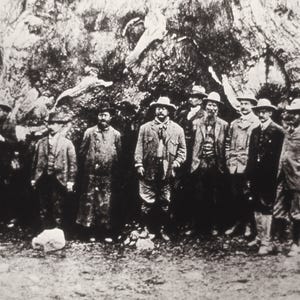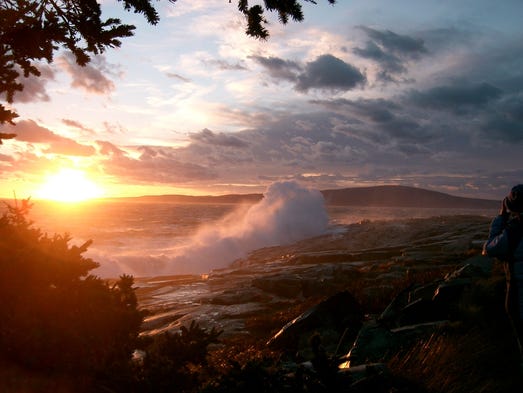Obama creates what could be the last large national park site on the East Coast, in Maine
New national monument won't settle Maine's north woods debate
Kevin Williams, USA Today
MILLINOCKET, Maine — President Obama ’s christening of 87,500 acres of pristine Maine forest as Katahdin Woods and Waters National Monument yesterday will do little to settle a long-running debate over federal reach into this rural outpost. Since the mid-1990s the idea of creating a national park in the north woods of Maine has been discussed and voted and legislated upon. In many ways, yesterday’s presidential action will simply heighten the debate, not settle it as some hope.
Meanwhile, as the back and forth continues, the fate of some down-on-their-luck mill towns hangs in the balance. Millinocket and the neighboring village of East Millinocket (the twin towns are sometimes called “The Mills”) were once prosperous company towns. The Great Northern Paper Company opened its first mill in 1900 and eventually operated three in the area. At the peak of Great Northern’s dominance it supplied close to 20% of the newsprint in the United States. But as the fortunes of the newspaper industry began to decline so did Great Northern’s. And when Great Northern closed for good in 2011, it took the towns down with it. Today, downtown Millinocket is a motley collection of empty storefronts, bars, and government offices. A handful of restaurants are open but their tables are largely empty. For some, the prospect of a North Woods National Park is the elixir that would cure the Mills’ ills and send desperately needed dollars coursing through the local economy.
It’s a national park designation — not a national monument — that will create the economic spark the area clearly needs.
“A national park is a marquee attraction, it would create a tourism corridor withAcadia National Park ,” says David Farmer, a spokesman for the Quimby family, who have spearheaded and funded the drive for a park, Acadia is a popular park on Maine’s coast which draws over 2 million visitors a year. Farmer, and other park supporters, are hoping the monument designation is the first step towards their ultimate goal of a national park.
“Many national parks first started out as national monuments. It is sort of a stepping stone to that,” says Farmer, citing Grand Teton National Park and the Grand Canyon as examples.
For some locals, the prestige that a national park confers can’t come quickly enough.
“Our economy is in free fall. Unemployment exceeds the national average. You have excess housing stock. The projection is that by 2030 the population will decline by another 30% if we do nothing” says Anita Mueller, a former Millinocket councilwoman who rode a pro-park platform to victory on town council in 2012 but resigned partly over frustration at local resistance to the park. Situated 10 miles from where the new national monument boundary will be, Millinocket is the closest town.
Resistance to the park (and national monument) among the town’s 4000 residents is widespread. Locals voted overwhelmingly against a park in a nonbinding referendum last year.
“I’m not a fan, there are too many unknowns,” says Roger Doyon, who works at a resort near the base of Katahadin. Doyon, like many who are against the park, shrug at why the Feds would want the land anyway.
“I’m not sure what the attraction would be. There’s no Old Faithful geyser , there’s nothing that would be a big draw,” Doyon says. He has lived in the area his whole life and says he and his wife enjoy the woods. There is also strong anti-Washington sentiment here that has people suspicious of a “national” anything, park or monument.
“I don’t like the idea of being restricted from what we can do. When Roxanne took over she cut off access,” said Doyon. “Roxanne” is the derisive shorthand many locals use when referring to Roxanne Quimby . The park is the vision of Quimby, theBurt’s Bees beauty products empire founder, and even park proponents agree that the initial roll-out was ham-handed. Quimby originally proposed a 3.2-million-acre park (for comparison Yellowstone is just over 2 million acres). Park supporters have since come back with a pared-down proposal that would set aside 75,000 acres as a national park, with 75,000 adjoining acres as a national recreation area. The recreation area would allow snowmobiling and other winter activities that are near-sacred to rural Maine life.
Despite local opposition driven by logging and snowmobiling interests, there are segments of the town cheering the concept of a national park near town.
Frost and McGibbon, like many residents here, once worked at Great Northern Paper, which showered the area with largesse and well-paying jobs. Frost worked in the mill for 27 years and remembers the day in 2011 that he was told it was shutting down. The loss of the mills caused young people to leave town in search of better jobs.
“There are no jobs here for people. I have two sons, one in Augusta and one in New York, I’d love to have my boys back here. The national park would create jobs,” Frost says.
“There are no jobs here for people. I have two sons, one in Augusta and one in New York, I’d love to have my boys back here. The national park would create jobs,” Frost says.
McGibbon was able to attend school and eventually land a job as a high school history and civics teacher. He also supports the concept of a national park.
“I tell my students that if something happens, adapt and overcome,” MGibbon says. “We have hit bottom in Millinocket and are crawling out, the park would be a part of that recovery.”
“I tell my students that if something happens, adapt and overcome,” MGibbon says. “We have hit bottom in Millinocket and are crawling out, the park would be a part of that recovery.”
Another group that is a firm proponent of the park is the Katahdin Area Chamber of Commerce.
“We talked about it quite a bit and took a vote from our members. The majority ruled that they were in favor,” said chamber vice-president Larry MacArthur, who makes wood products in a small studio outside his house.
But any hope for the park to attain national park status rests with Maine’s Congressional delegation. And with anti-Washington sentiment high, getting Congress on board has been a tough sell. That is why park proponents pinned their hopes on a monument. Under the Antiquities Act , the president can declare an area a national monument without Congressional approval. And that is just what he did, an action that Maine’s senior senator criticized.
“Senator Collins continues to have significant concerns about the proposal to designate a national monument in the Katahdin region. As a general matter, she believes it is a mistake for the president to designate land under the Antiquities Act without the support of the state or the local communities. Despite a determined effort by park advocates, this proposal has failed to earn a consensus,” says Collins communications director Annie Clark.
Meanwhile, summer is on the wane in Millinocket, which enjoys a postcard panorama of Katahdin and its cap of snow which lasts well into May. Park supporters envision a town filled with boutiques and restaurants, all savoring the view and welcoming hikers who are finishing their treks on the Appalachian Trail , which has its northern terminus on Katadhin. Supporters of the park think there would still be plenty of land left for logging while the park — if it one day comes to fruition — helps takes Millinocket off life-support.
“Northern Maine is 93% forest, what do (the loggers) need that little bit for?” quippedJudy Paradis , a former state legislator and park proponent.
“Northern Maine is 93% forest, what do (the loggers) need that little bit for?” quipped











No comments:
Post a Comment